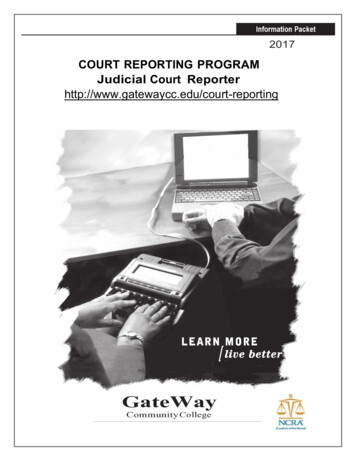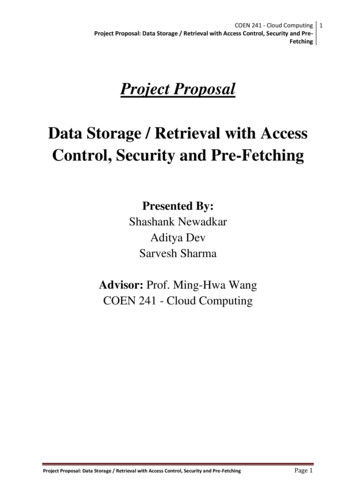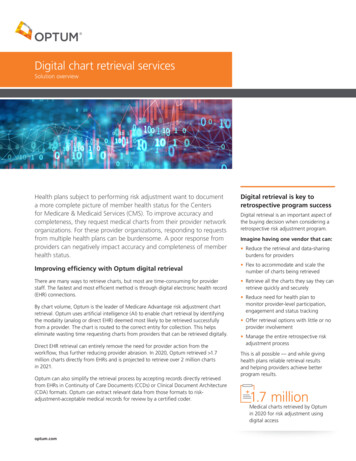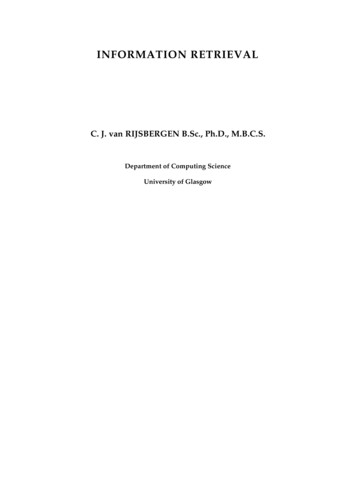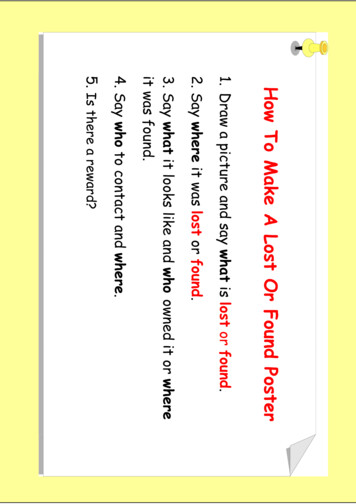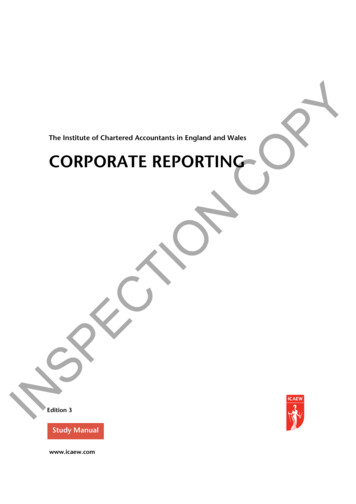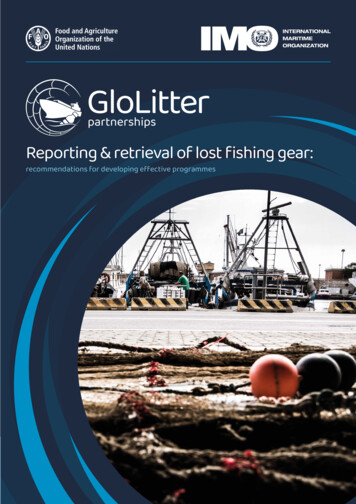
Transcription
Reporting & retrieval of lost fishing gear:recommendations for developing effective programmes01
Reporting and retrieval of lost fishing gear:recommendations for developing effective programmesByJoan DrinkwinFAO ConsultantSeattle, the United States of AmericaPublished bythe Food and Agriculture Organization of the United Nationsandthe International Maritime OrganizationRome, 2022
Required citation:Drinkwin, J. 2022. Reporting and retrieval of lost fishing gear: recommendations fordeveloping effective programmes. Rome, FAO and IMO. https://doi.org/10.4060/cb8067enThe designations employed and the presentation of material in this information product donot imply the expression of any opinion whatsoever on the part of the Food and AgricultureOrganization of the United Nations (FAO) or the International Maritime Organization (IMO)concerning the legal or development status of any country, territory, city or area or of itsauthorities, or concerning the delimitation of its frontiers or boundaries. The mention of specificcompanies or products of manufacturers, whether or not these have been patented, does notimply that these have been endorsed or recommended by FAO or IMO in preference to othersof a similar nature that are not mentioned. The views expressed in this information productare those of the author(s) and do not necessarily reflect the views or policies of FAO or IMO.ISBN 978-92-5-135540-4 [FAO] FAO and IMO, 2022Some rights reserved. This work is made available under the Creative Commons AttributionNonCommercial-ShareAlike 3.0 IGO licence (CC BY-NC-SA 3.0 IGO; igo/legalcode).Under the terms of this licence, this work may be copied, redistributed and adapted fornon-commercial purposes, provided that the work is appropriately cited. In any use of thiswork, there should be no suggestion that FAO and IMO endorse any specific organization,products or services. The use of the logos of FAO and IMO is not permitted. If the work isadapted, then it must be licensed under the same or equivalent Creative Commons license.If a translation of this work is created, it must include the following disclaimer along with therequired citation: “This translation was not created by the Food and Agriculture Organizationof the United Nations (FAO) or the International Maritime Organization (IMO). FAO and IMO arenot responsible for the content or accuracy of this translation. The original English edition shallbe the authoritative edition.”Disputes arising under the licence that cannot be settled amicably will be resolved by mediationand arbitration as described in Article 8 of the licence except as otherwise provided herein. ww.wipo.int/amc/en/mediation/rules and any arbitration will be in accordance with theArbitration Rules of the United Nations Commission on International Trade Law (UNCITRAL)Third-party materials. Users wishing to reuse material from this work that is attributed to a thirdparty, such as tables, figures or images, are responsible for determining whether permissionis needed for that reuse and for obtaining permission from the copyright holder. The risk ofclaims resulting from infringement of any third-party-owned component in the work restssolely with the user.Sales, rights and licensing. FAO information products are available on the FAO website (www.fao.org/publications) and can be purchased through publications-sales@fao.org. Requests forcommercial use should be submitted via: www.fao.org/contact-us/licence-request. Queriesregarding rights and licensing should be submitted to: copyright@fao.org.Cover photograph: FAO/Cristiano Minichiello
Preparation of this documentThis document, Reporting and retrieval of lost fishing gear: recommendationsfor developing effective programmes, was prepared by the Fishing Technologyand Operations Team of the Fisheries and Aquaculture Division of the Food andAgriculture Organization of the United Nations (FAO).The work was funded by the GloLitter Partnerships project phase I (UNJP/GLO/051/IMO). GloLitter is implemented by the International Maritime Organization (IMO)in collaboration with FAO; initial funding was provided by the Government ofNorway via the Norwegian Agency for Development Cooperation (Norad).This report is one of the knowledge products contributing to GloLitter Outcome 1:Knowledge products and capacity building tools are developed in support of wider capacitybuilding on the subject; and disseminated to expand global awareness and stakeholders’support in dealing with sea-based sources of marine plastic litter.This report is based on work conducted by Ms Joan Drinkwin under the technicalsupervision and coordination of Mr Jon Lansley and Ms Amparo Perez Roda, LeadTechnical Officer and project coordinator of the FAO components of GloLitter.iii
AbstractAbandoned, lost or otherwise discarded fishing gear, also referred to as ALDFG orghost gear, is the most harmful form of marine plastic litter for marine animals andhabitats: it can impede safe navigation, damage beaches and reefs, and lead toeconomic losses for fisheries and other marine-dependent industries across theglobe. While there are no current estimates of the amount of ALDFG in the ocean,a growing body of evidence has documented high rates of ALDFG in fisheriesaround the world. This state of affairs increases costs for fisheries, harms theenvironment, and presents significant safety risks. Given that most fishing gearhas a significant number of plastic components, ALDFG also gives rise to a seriesof less direct but longer-term negative impacts associated with other plasticpollution and microplastics, including negative effects on biota, water quality andeven human health.Providing solutions to ALDFG on a global scale has gained momentum with the effortsof FAO, the United Nations Environment Programme (UNEP) and the IMO throughtheir respective multilateral fora: Committee on Fisheries (COFI), United NationsEnvironment Assembly (UNEA) and Marine Environment Protection Committee(MEPC). Other significant initiatives and actions include: the endorsement andpublication of the Voluntary Guidelines on the Marking of Fishing Gear (VGMFG;FAO, 2019a); the IMO action plan to address marine plastic litter from ships; thecreation of the Global Ghost Gear Initiative (GGGI); and the establishment of theJoint Group of Experts on the Scientific Aspects of Marine Environmental Pollution(GESAMP) Working Group 43. These efforts reflect the growing understanding thatALDFG is a considerable and damaging source of marine plastic litter in the ocean.At the same time, the publication of the FAO VGMFG and the GGGI Best PracticeFramework (BPF) for the management of fishing gear show that there are nowreferences for how to prevent loss of fishing gear and prevent harm from ALDFG.Focusing on two key recommendations outlined by the VGMFG and the BPF, thisreport describes systems for fisher-led reporting and retrieval of lost fishing gear. Indoing so it identifies critical elements of successful programmes and recommendsnext steps for countries to develop such programmes in their turn.iv
ContentsPreparation of this documentAbstractiiiivAbbreviations and acronymsviiiExecutive summaryxIntroductionGloLitter Partnerships ProjectAbandoned, lost or otherwise discarded fishing gearVoluntary Guidelines on the Marking of Fishing GearBest Practices Framework for the Management of Fishing GearsImportance of reporting and retrieval112456GloLitter participating countriesFisheries summariesGlobal Fishing Watch informationAfrica regionAsia regionCaribbean regionLatin AmericaPacific regionAbandoed, lost or otherwise discarded fishing gear(ALDFG) management in participating countries778101723243133Effective reporting and retrieval programmesCase studiesPuget Sound Reporting, Response and Retrieval ProgramNorwegian Directorate of Fisheries abandoned, lost or otherwisediscarded fishing gear (ALDFG) Reporting and RetrievalFishing for LitterEnaleia Mediterranean CleanupFishing Net Gains AfricaWashington Coast crab tag programArea A Crab AssociationConsiderations for the development of reportingand retrieval endix. Country questionnaire83454750525558v
FiguresFigure 1A. Percent and number of countries that require fishers to report lost gearB. Percent and number of countries with reporting system in placeto receive reports of lost gear34Figure 2A. Percent and number of countries that require fishers to retrievetheir lost gearB. Percent and number of countries that prohibit fishers from retrievingother fishers’ ALDFG34Figure 3Percent and number of countries that identified specified barriersto ALDFG retrieval35Figure 4A. Percent and number of countries that require marking of fishing gearB. Percent and number of countries reporting adequate wastereception facilities36Figure 5Types of support structures and organizations supporting the reportingand retrieval of ALDFG named by more than one country36vi
TablesTable 1Participating countries7Table 2Number of unique Maritime Mobile Service Identity (MMSI) by region,country, and gear type for 20199Table 3ALDFG Retrieval programme examples39Table 4Summary of key ALDFG retrieval programme criteria58vii
Abbreviations and acronymsACAPAgreement on the Conservation of Albatrosses and PetrelsaFADanchored fish aggregating deviceALDFGAbandoned, lost or otherwise discarded fishing gearAPFICAsia-Pacific Fishery CommissionATLAFCOMinisterial Conference on Fisheries Cooperation among AfricanStates bordering the AtlanticBOBP-IGOBay of Bengal Programme-Intergovernmental OrganizationBPFBest Practice Framework for the Management of Fishing GearsCBLTLake Chad Basin CommissionCCAMLRCommission for the Conservation of Antarctic Marine LivingResourcesCCSBTCommission for the Conservation of Southern Bluefin TunaCECAFFishery Committee for the Eastern Central AtlanticCIFAACommittee for Inland Fisheries and Aquaculture of AfricaCOFICommittee on FisheriesCOPESCAALCCommission for Fisheries and Aquaculture for Latin Americaand the CaribbeanCPPSPermanent Commission for the South PacificCRFMCaribbean Regional Fisheries MechanismCTMFMJoint Technical Commission of the Maritime FrontFADfish aggregation deviceFAOFood and Agriculture Organization of the United NationsFCWCFishery Committee for the West Central Gulf of GuineaFFAForum Fisheries P JointGroup of Experts on the Scientific Aspects of MarineEnvironmental ProtectionGFCMGeneral Fisheries Commission for the MediterraneanGGGIGlobal Ghost Gear InitiativeGIAGlobal Industry AllianceIATTCInter-American Tropical Tuna CommissionICCATInternational Commission for the Conservation of AtlanticTunasIGO Intergovernmental OrganizationIMOInternational Maritime OrganizationINFOFISHIntergovernmental Organization Marketing Informationand Technical Advisory Services to the fishery industry inthe Asia-PacificIOTCIndian Ocean Tuna CommissionIUUillegal, unregulated, and unreported fishingIWCInternational Whaling CommissionLPClead partnering countryLVFOLake Victoria Fisheries OrganizationMEPCMarine Environment Protection CommitteeMPLmarine plastic litterMRCMekong River CommissionNACANetwork of Aquaculture Centres in Asia and the Pacificviii
Abbreviations and acronymsNAFONorthwest Atlantic Fisheries CommissionNASCONorth Atlantic Salmon Conservation OrganizationNEAFCNorth East Atlantic Fisheries CommissionNGOnon-governmental organizationNoradNorwegian Agency for Development CooperationNPAFCNorth Pacific Anadromous Fish CommissionNPFCNorth Pacific Fisheries CommissionOLDEPESCALatin American Organization for Fisheries DevelopmentOSPESCACentral American Organization of the Fisheries andAquaculture SectorPC partnering countryPERSGARegional Organization for the Conservation of the Environmentof the Red Sea and Gulf of AdenPNAParties to the Nauru AgreementPSCPacific Salmon CommissionRAAAquaculture Network for the AmericasRECOFIRegional Commission for FisheriesRFBregional fishery bodyRFMOregional fisheries management organizationSEAFDECSoutheast Asian Fisheries Development CenterSIOFASouthern Indian Ocean Fisheries AgreementSPCSecretariat of the Pacific CommunitySPREPSecretariat of the Pacific Regional Environment ProgrammeSPRFMOSouth Pacific Regional Fisheries Management OrganisationSWIOFCSouthwest Indian Ocean Fisheries CommissionUNEAUnited Nations Environment AssemblyUNEPUnited Nations Environment ProgrammeVGMFGVoluntary Guidelines on the Marking of Fishing GearWCPFCWestern and Central Pacific Fisheries CommissionWECAFCWestern Central Atlantic Fishery Commissionix
Executive summaryThis report is a product of the GloLitter Partnerships project phase I implementedby the International Maritime Organization (IMO) and the Food and AgricultureOrganization of the United Nations (FAO). It was made possible thanks to initialfunding from the Government of Norway via the Norwegian Agency for DevelopmentCooperation (Norad). GloLitter assists developing countries in reducing marineplastic litter (MPL) from the maritime transport and fisheries sectors. Ten countries,from five high-priority regions (Asia, Africa, Caribbean, Latin America and thePacific) are participating as the lead partnering countries1 (LPCs) to championnational actions in the context of supporting the IMO Action Plan to addressmarine plastic litter from ships and the FAO Voluntary Guidelines on the Markingof Fishing Gear (VGMFG). Based on the successes and lessons learned, the LPCswill support 20 selected partnering countries2 (PCs) via twinning arrangements toaddress the MPL issues and build further regional support for the project. Twinningarrangements between countries that have similar priorities and challenges whenaddressing the issue of MPL from the maritime transportation and/or fisheriessectors will be established and will receive support from the GloLitter to implementselected joint initiatives.The aim of this report, as one of the deliverables under Activity 1.1.1 of theGloLitter project, is to motivate the adoption and replication of effective fisheriesmanagement strategies for the fisher-led reporting and retrieval of abandoned, lostand otherwise discarded fishing gear (ALDFG). The report presents the results froma survey provided to LPCs and PCs, summarizing the status of ALDFG reportingand retrieval activities, and providing examples of effective approaches around theworld that support ALDFG reporting and fisher-led retrieval. Finally, it considersseveral case studies of programmes that could be replicated in LPCs and PCs.Abandoned, lost or otherwise discarded fishing gear, also referred to as ALDFGor ghost gear, is the most harmful form of marine plastic litter for marine animalsand habitats: it can impede safe navigation, damage beaches and reefs, and leadto economic losses for fisheries and other marine-dependent industries across theglobe. While there are no current estimates of the amount of ALDFG in the ocean, agrowing body of evidence has documented high rates of ALDFG in fisheries aroundthe world. This state of affairs increases costs for fisheries, harms the environment,and presents significant safety risks. Given that most fishing gear has a significantnumber of plastic components, ALDFG also gives rise to a series of less direct butlonger-term negative impacts associated with other plastic pollution and microplastics,including negative effects on biota, water quality and even human health.Providing solutions to ALDFG on a global scale has gained momentum with theefforts of FAO, the United Nations Environment Programme (UNEP) and the IMOGloLitter Lead Partnering Countries are: Brazil, Costa Rica, Cote d’Ivoire, India, Indonesia, Jamaica,Kenya, Madagascar, Nigeria and Vanuatu.2GloLitter Partnering Countries are: Argentina, Cabo Verde, Columbia, Ecuador, Gambia, Mozambique,Nicaragua, Panama, Peru, Philippines, Senegal, Sri Lanka, Solomon Islands, Sudan, United Republicof Tanzania, Thailand, Timor-Leste, Togo, Tonga and Viet Nam.1x
Executive summarythrough their respective multilateral fora (COFI, UNEA and MEPC). Other significantinitiatives and actions include: the endorsement and publication of the VoluntaryGuidelines on the Marking of Fishing Gear (VGMFG; FAO, 2019a); the IMO actionplan to address marine plastic litter from ships; the creation of the Global GhostGear Initiative (GGGI); and the establishment of the Joint Group of Experts on theScientific Aspects of Marine Environmental Pollution (GESAMP) Working Group43. These efforts reflect the growing understanding that ALDFG is a considerableand damaging source of marine plastic litter in the ocean. At the same time, thepublication of the VGMFG and the Best Practice Framework for the Managementof Fishing Gear (BPF) show that there are now references for how to prevent lossof fishing gear and prevent harm from ALDFG.Focusing on two key recommendations outlined by the VGMFG and the BPF, thisreport describes systems for fisher-led reporting and retrieval of lost fishing gear. Indoing so it identifies critical elements of successful programmes and recommendsnext steps for LPCs and PCs to develop such programmes in their turn. The reportalso provides brief summaries of each LPC and PC fisheries, as well as the currentstate of their knowledge of ALDFG.To gain a better understanding of the current ALDFG management practices inLPCs and PCs, a country questionnaire was developed and distributed to eachnational focal point. The questionnaire included questions relating to the reportingand retrieval of lost fishing gear, the marking of fishing gear, waste receptionfacilities, and the country’s capacity for managing ALDFG. A total of 25 countriesresponded to the questionnaire, providing valuable insights into current ALDFGmanagement practices and thus the potential capacity to support ALDFG reportingand fisher-led retrieval activities further.The 25 countries that responded to the questionnaire answered all questions, withone exception. With regards to the reporting of ALDFG, 8 countries (33 percent)indicated that they require fishers who lose gear to report that loss in at least someof their fisheries, while 16 countries (67 percent) had no requirements in place toreport lost fishing gear. With regards to requirements to retrieve ALDFG, 6 countries(24 percent) indicated that they require fishers who lose gear to attempt to retrieveit in at least some of their fisheries, while 19 countries (76 percent) indicated that nosuch requirements were in place. When asked to identify the predominant barrierspreventing fishers from retrieving their own ALDFG and/or ALDFG encountered at sea,the most frequent barrier referred to was space on deck of the fishing vessels, followedby economic barriers, including the cost of disposing of retrieved ALDFG. When askedwhether the marking of gear was required, 11 countries (44 percent) indicated thatfishing gear marking was required in at least some of their fisheries, while 14 countries(56 percent) indicated that no fishing gear marking was required. When askedwhether there were adequate waste reception facilities available to fishers for ALDFGdisposal, only 21 countries answered this question. Of these, 4 countries (19 percent)indicated that adequate waste reception facilities existed for fishers to dispose ofALDFG, while 17 countries (81 percent) indicated that waste reception facilities werenot adequate. Countries also provided details on potential capacity, structures, andexisting programmes to support the reporting and retrieval of ALDFG.The report provides seven case studies of effective reporting and fisher-led retrievalprogrammes from around the world. The Puget sound Reporting, Response, andxi
Reporting and retrieval of lost fishing gear: recommendations for developing effective programmesRetrieval Program involves a rapid response to mandated reports of lost fishingnets. The response process includes mobilizing a team of trained divers to retrievelost nets. Norwegian Directorate of Fisheries ALDFG Reporting and Retrieval is ledby the fisheries authority, which charters a fishing vessel for several weeks in orderto retrieve ALDFG from areas where fishers have reported loss. The Fishing forLitter and the Mediterranean Cleanup programmes involve fishers in collecting andbringing back to port any marine litter and ALDFG they have encountered duringactive fishing. The Fishing Net Gains Africa project involves fishers in the collectionand deposit of end-of-life and ALD nets to Fishing-HubNets: here, the nets areprocessed for disposal or upcycling into marketable items by community women.The Washington Coast Crab Tag and Area A Crab Association programmes bothengage crab fishermen to retrieve lost crab pots.The report provides guidance on the development of pilot ALDFG reporting andfisher-led retrieval projects. Aspects to be considered when developing pilot ALDFGreporting and retrieval projects include: the status of national programmes andpotential partners, in addition to other key capacity criteria that have varying levelsof importance. These capacity criteria include: the status of ALDFG reporting; thenecessary level of effort or involvement from fishers, fisher associations, fisheriesauthorities and ports; costs and funding. Pilot projects can be designed to matchthe capacity available with the capacity required, as per successful projectexamples described in the Case Studies section. As with any effective fisheriesmanagement strategy, continual and upfront consultation and collaboration withfishers and fisher associations will ensure that pilot project designs are feasibleand supported by industry.In conclusion, the report includes the following recommendations to strengthenALDFG reporting and fisher-led retrieval programmes in the LPCs and PCs: Create and strengthen requirements and incentives for fishers to retrieve gearthat they lose, if safe to do so, and to carry appropriate tools and equipment ontheir vessel for the retrieval of lost gear. Support programmes and recycling initiatives such as Fishing for Litter to facilitatethe collection and proper disposal of ALDFG encountered during active fishingand end-of-life fishing gear. Support the retrieval of gillnets lost at sea. Support the retrieval of lost traps and pots by participating fishers. Develop ALDFG reporting systems and registries that are appropriate to localfisheries in order to document the extent and location(s) of lost fishing gear, andto inform prevention and remediation activities. As members of RFMOs, promote binding measures around the reporting andretrieval of ALDFG.xii
IntroductionGloLitter Partnerships ProjectThis report is a product of the GloLitter Partnerships project phase I implementedby the International Maritime Organization (IMO) and the Food and AgricultureOrganization of the United Nations (FAO); initial funding was provided by theGovernment of Norway via the Norwegian Agency for Development Cooperation(Norad). GloLitter assists developing countries in reducing marine plastic litter(MPL) from the maritime transport and fisheries sectors. The project strengthensgovernment and port management institutional capacities in addressing MPL issuesand supports legal, policy and institutional reforms at the country level. GloLitterachieves its objectives by focusing on several areas identified in the recentlyadopted IMO Action Plan to address MPL from ships, as well as in complementaryactions as identified by FAO, such as supporting the provisions of the VoluntaryGuidelines for the Marking of Fishing Gear (VGMFG).Through its partnerships, GloLitter will spur global efforts to demonstrate and testbest practices to deal with MPL and enhance global knowledge, managementand information sharing. The partnership effort is three-tiered, involving global,regional, and national partners as represented by government, industry and nongovernmental organizations. Private-sector participation will also be achievedthrough the development of a Global Industry Alliance (GIA) in collaboration withUN Global Compact, with partners from major maritime and fisheries companies.Ten countries, from five high-priority regions (Asia, Africa, Caribbean, LatinAmerica and the Pacific) are participating as the lead partnering countries3 (LPC)to champion national actions in the context of supporting the IMO Action Plan andthe FAO Voluntary Guidelines for the Marking of Fishing Gear (VGMFG). Based onthe successes and lessons learned, the LPCs will support 20 selected partneringcountries4 (PCs) via a twinning arrangement to address the MPL issues and buildadditional regional support for the project. Twinning arrangements betweencountries that have similar priorities and challenges when addressing the issue ofMPL from the maritime transportation and/or fisheries sectors will be establishedand will receive support from the GloLitter to implement selected joint initiatives.The aim of this report is to motivate the adoption and replication of effective fisheriesmanagement strategies for the reporting and fisher-led retrieval of abandoned, lostand otherwise discarded fishing gear (ALDFG). The report presents the results froma survey provided to LPCs and PCs, summarizing the status of ALDFG reportingand retrieval activities, and providing examples of effective approaches around theworld that support ALDFG reporting and fisher-led retrieval. Finally, it considersseveral case studies of programmes that could be replicated in LPCs and PCs. Thereport describes systems for fisher-led reporting and retrieval of lost fishing gear,GloLitter Lead Partnering Countries: Brazil, Costa Rica, Cote d’Ivoire, India, Indonesia, Jamaica,Kenya, Madagascar, Nigeria and Vanuatu4GloLitter Partnering Countries are: Argentina, Cabo Verde, Columbia, Ecuador, Gambia, Mozambique,Nicaragua, Panama, Peru, Philippines, Senegal, Sri Lanka, Solomon Islands, Sudan, United Republic ofTanzania, Thailand, Timor-Leste, Togo, Tonga and Viet Nam.31
Reporting and retrieval of lost fishing gear: recommendations for developing effective programmesidentifies critical elements of successful programmes, and recommends next stepsfor countries to develop such programmes in their turn.Abandoned, lost or otherwise discarded fishing gearFisheries and aquaculture feed over 3.3 billion people globally. In 2018, an estimated4.56 million fishing vessels operated across the globe. Marine capture fisheriesproduction reached 84.4 million tonnes, a 5.4 percent increase over the previousthree-year average (FAO, 2020a). With this fishing effort comes accidental lossand, at times, the intentional abandonment and discard of fishing gear. Abandoned,lost, or otherwise discarded fishing gear, also known as ALDFG or ghost gear,is the most harmful form of marine plastic litter for marine animals and habitats(Wilcox et al., 2016)determining the consequences of this debris on marine faunaand ocean health has now become a critical environmental priority, particularly forthreatened and endangered species. However, there are limited data about theimpacts of debris on marine species from which to draw conclusions about thepopulation consequences of anthropogenic debris. To address this knowledgegap, information was elicited from experts on the ecological threat (both severityand specificity. It also can impede safe navigation, damage beaches and reefs,and lead to economic losses for fisheries and other marine-dependent industriesacross the globe. The VGMFG define ALDFG as follows: “Abandoned fishing gear” means fishing gear over which that operator/ownerhas control and that could be retrieved by owner/operator but is deliberately leftat sea due to force majeure or other unforeseen reasons. “Lost fishing gear” means fishing gear over which the owner/operator hasaccidentally lost control and that cannot be located and/or retrieved by owner/operator. “Discarded fishing gear” means fishing gear that is released at sea without anyattempt for further control or recovery by the owner/operator (FAO, 2019a).In this report, the term ALDFG or ‘lost fishing gear’ will be generally be employedunless specifically referring to abandoned or intentionally discarded gear. Theterm ‘ghost gear’ will only be used to refer to ALDFG known to be ghost fishing.The often referenced estimate that 640 000 tonnes of ALDFG are lost annuallyto the world’s ocean is likely originated from a now 45-year old study by theNational Academy of Sciences (NAS) that examined marine litter, including litterfrom commercial fishing, as part of a larger study around assessment of oceanpollutants (Gilardi et al., 2020; NAS, 1975). A recent UNEP publication reportedthat, by volume, ALDFG accounts for 70 percent all macro-plastic marine litter inthe oceans (UNEP, 2016). These numbers play out at regional scales with annualestimates of 38 535 tonnes of fishing gear lost in the Republic of Korea, 10 000gillnets lost in the Baltic Sea, and more than 12 000 crab pots lost in the UnitedStates of America Salish Sea (Antonelis et al., 2011; Kim et al., 2014; Szulc et al.,2015). In the Western Central Pacific Ocean, estimates of the number of driftingFADs washing up (beaching) onto nearshore habitats every year, having beenabandoned, ranges from 9 254 to 13 436 (Banks and Zaharia, 2020). This gearloss adds to the growing mass of plastics entering our oceans every year. Twoother recent studies attempted a global estimate of rates of fishing gear loss:2
IntroductionRichardson et al. (2019b) estimated that 5.7 percent of fishing nets, 8.6 percent oftraps and pots, and 29 percent of fishing lines used globally are lost, abandonedor otherwise discarded into the environment. Lively and Good (2018) estimatedannual losses as 3–7 net panels/boat or 38
Reporting & retrieval of lost fishing gear: . damage beaches and reefs, and lead to economic losses for fisheries and other marine-dependent industries across the globe. While there are no current estimates of the amount of ALDFG in the ocean, . report describes systems for fisher-led reporting and retrieval of lost fishing gear. In


